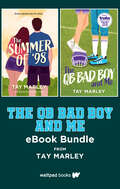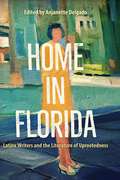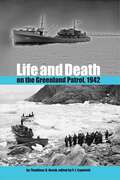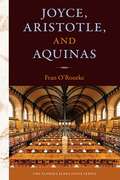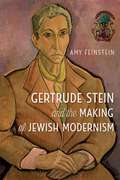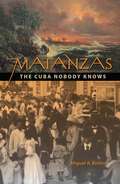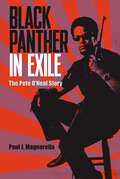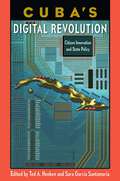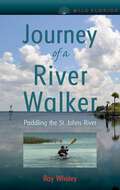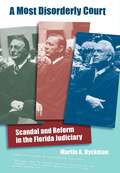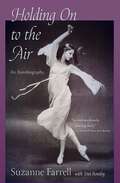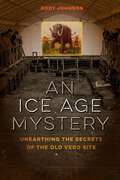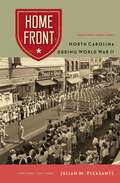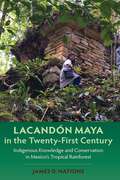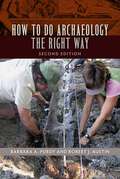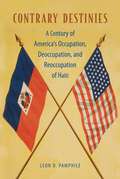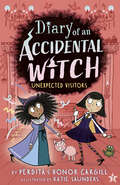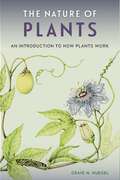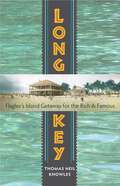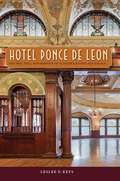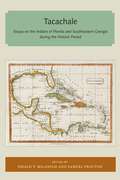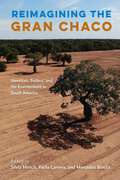- Table View
- List View
The QB Bad Boy and Me eBook Bundle: A Two Book Bundle including The Summer of '98
by Tay MarleyIncludes the novel that inspired the Tubi movie starring Noah Beck and Siena Agudong!This ebook bundle brings together both of the QB Bad Boy and Me novels from Tay Marley! The QB Bad Boy and Me Reluctant cheerleader Dallas Bryan has a problem on her hands—and his name is Drayton Lahey. Ever since the hot star quarterback of the high school football team hit her car with his motorcycle, he has the annoying ability to get under her skin, making Dallas think about Drayton way more than she should . . . in all the ways that she shouldn't. But Dallas has one goal—to pursue her dance-school dreams in California—and no one, not even a hard-bodied, green-eyed football god, will stop her. As the tension between Drayton and Dallas grows thicker, the lines blur, and all she wants is to come undone under his touch.But this thing between Dallas and Drayton could cost her her dreams . . . if he doesn't break her heart first.The Summer of '98 Before Drayton and Dallas, there was Ellie and Leroy . . . Sometimes home isn&’t a place, it&’s a person. From the moment their eyes met, Ellie knew he would be her destiny. Handsome and ripped, there&’s just something about Leroy Lahey, Baylor University&’s soon-to-be star quarterback, that makes him impossible to resist. Consumed by a passion neither one of them can quite understand, Leroy and Ellie spend the summer together. Left senseless and overwhelmed by his touch, Ellie experiences a world of desire she could never have imagined. Safe in Leroy&’s arms, Ellie begins to see a life beyond high school: going to college, starting her own business, having a family. But when life-altering news shakes them to their cores, Leroy and Ellie must discover if their passion is enough to help them get through what might possibly be the greatest challenge of their lives.
Home in Florida: Latinx Writers and the Literature of Uprootedness
by Anjanette DelgadoIndependent Publisher Book Awards, Silver Medal for AnthologyNational Indie Excellence Awards, Finalist in the Anthology CategoryInternational Latino Book Awards, Gold Medal for Best Fiction (Multi-Author)International Latino Book Awards, Honorable Mention, Best Nonfiction (Multi-Author)A powerful collection of contemporary voices Showcasing a variety of voices shaped in and by a place that has been for them a crossroads and a land of contradictions, Home in Florida presents a selection of the best literature of displacement and uprootedness by some of the most talented contemporary Latinx writers who have called Florida home. Featuring fiction, nonfiction, and poetry by Richard Blanco, Jaquira Díaz, Patricia Engel, Jennine Capó Crucet, Reinaldo Arenas, Judith Ortiz Cofer, and many others, this collection of renowned and award-winning contributors includes several who are celebrated in their countries of origin but have not yet been discovered by readers in the United States. The writers in this volume—first- , second- , and third-generation immigrants to Florida from Cuba, Mexico, Honduras, Perú, Argentina, Chile, and other countries—reflect the diversity of Latinx experiences across the state. Editor Anjanette Delgado characterizes the work in this collection as literature of uprootedness, literatura del desarraigo, a Spanish literary tradition and a term used by Reinaldo Arenas. With the heart-changing, here-and-there perspective of attempting life in environments not their own, these writers portray many different responses to displacement, each occupying their own unique place on what Delgado calls a spectrum of belonging. Together, these writers explore what exactly makes Florida home for those struggling between memory and presence. In these works, as it is for many people seeking to make a new life in the United States, Florida is the place where the uprooted stop to catch their breath long enough to wonder, “What if I stayed? What if here could one day be my home?”Contributors: Richard Blanco | Daniel Reschinga | Ana Menéndez | Frances Negrón Muntaner | Hernán Vera Álvarez | Liz Balmaseda | Ariel Francisco | Andreina Fernandez | Amina Lolita Gautier | Jennine Capó-Crucet | Dainerys Machado Vento | Carlos Harrison | Legna Rodríguez Iglesias | Judith Ortiz Cofer | Chantel Acevedo | Guillermo Rosales | Achy Obejas | Alex Segura | Patricia Engel | Anjanette Delgado | Mia Leonin | Carlos Pintado | Nilsa Ada Rivera | Natalie Scenters-Zapico | Pedro Medina León | Caridad Moro-Gronlier | Aracelis González Asendorf | Michael García-Juelle | Jaquira Díaz | José Ignacio Chascas-Valenzuela | Raúl Dopico | Javier Lentino | Yaddyra Peralta
Life and Death on the Greenland Patrol, 1942 (New Perspectives on Maritime History and Nautical Archaeology)
by Thaddeus D. NovakOne of the untold stories of World War II is the guarding of Greenland and its coastal waters, where the first U.S. capture of an enemy ship took place. For six months in 1942 and against standing orders of the time, Thaddeus Nowakowski (now Novak) kept a personal diary of his service on patrol in the North Atlantic. Supplemented by photos from his last surviving shipmates, Novak’s diary fills a void in the story of American sailors at war in the North Atlantic. It is the only known diary of an enlisted Coast Guard sailor to emerge from WWII.
Joyce, Aristotle, and Aquinas (The Florida James Joyce Series)
by Fran O'RourkeA rich examination of the influence of Aristotle and Thomas Aquinas on James Joyce In this book, Fran O’Rourke examines the influence of Aristotle and Thomas Aquinas on James Joyce, arguing that both thinkers fundamentally shaped the philosophical outlook which pervades the author’s oeuvre. O’Rourke demonstrates that Joyce was a philosophical writer who engaged creatively with questions of diversity and unity, identity, permanence and change, and the reliability of knowledge. Beginning with an introduction to each thinker, the book traces Joyce’s discovery of their works and his concrete engagement with their thought. Aristotle and Aquinas equipped Joyce with fundamental principles regarding reality, knowledge, and the soul, which allowed him to shape his literary characters. Joyce appropriated Thomistic concepts to elaborate an original and personal aesthetic theory. O’Rourke provides an annotated commentary on quotations from Aristotle that Joyce entered into his famous Early Commonplace Book and outlines their crucial significance for his writings. He also provides an authoritative evaluation of Joyce’s application of Aquinas’s aesthetic principles. The first book to comprehensively illuminate the profound impact of both the ancient and medieval thinker on the modernist writer, Joyce, Aristotle, and Aquinas offers readers a rich understanding of the intellectual background and philosophical underpinnings of Joyce’s work. A volume in the Florida James Joyce Series, edited by Sebastian D. G. Knowles
Gertrude Stein and the Making of Jewish Modernism
by Amy FeinsteinChallenging the assumption that modernist writer Gertrude Stein seldom integrated her Jewish identity and heritage into her work, this book uncovers Stein’s constant and varied writing about Jewish topics throughout her career. Amy Feinstein argues that Judaism was central to Stein’s ideas about modernity, showing how Stein connects the modernist era to the Jewish experience. Combing through Stein’s scholastic writings, drafting notebooks, and literary works, Feinstein analyzes references to Judaism that have puzzled scholars. She reveals the never-before-discussed influence of Matthew Arnold as well as a hidden Jewish framework in Stein’s epic novel The Making of Americans. In Stein’s experimental “voices” poems, Feinstein identifies an explicitly Jewish vocabulary that expresses themes of marriage, nationalism, and Zionism. She also shows how Wars I Have Seen, written in Vichy France during World War II, compares the experience of wartime occupation with the historic persecution of Jews. Affirming the importance of Jewish identity and modernist style to Gertrude Stein’s legacy as a writer, this book radically changes the way we read and appreciate Stein’s work.
Matanzas: The Cuba Nobody Knows
by Miguel A. BretosMatanzas--the name means literally "slaughters"--is the Cuban city nearest the United States. Known at the heyday of the nineteenth-century sugar boom as the "Athens of Cuba," it is renowned for its art, its music, and its rich African heritage. It is also the place where Latin American baseball began. Yet most Americans have never heard of it.Miguel Bretos's fascinating history of his hometown remedies this oversight. Though he came to the United States as a Pedro Pan child and has lived all over the world, his family is still closely tied to the city where they lived for generations. After forty years he returned to his homeland "with the longing of an exile, the anticipation of a child, the curiosity of a visitor, the resentment of a victim, and--hopefully--the objectivity of a scholar."Bretos unfolds the Matanzas story from the aboriginal Tainos to the coming of revolution with solid research, wit, clarity, and the kind of vivid detail that can come only from an insider. But he also deftly inserts Matanzas into a larger picture. More than local history, this original work is Cuban history from a local perspective.
Black Panther in Exile: The Pete O'Neal Story
by Paul J. MagnarellaIn the tumultuous year after Martin Luther King Jr.’s assassination, 29-year-old Pete O’Neal became inspired by reading The Autobiography of Malcolm X and founded the Kansas City branch of the Black Panther Party (BPP). The same year, FBI director J. Edgar Hoover declared the BPP was the “greatest threat to the internal security of the country.” Black Panther in Exile is the gripping story of O’Neal, one of the influential members of the movement, who now lives in Africa—unable to return to the United States but refusing to renounce his past. Arrested in 1969 and convicted for transporting a shotgun across state lines, O’Neal was free on bail pending his appeal when Fred Hampton, chairman of the Illinois chapter of the BPP, was assassinated by the police. O’Neal and his wife fled the United States for Algiers. Eventually they settled in Tanzania, where the O’Neals continue the social justice work of the Panthers through community and agricultural programs and host study-abroad programs for American students. Paul Magnarella—a veteran of the United Nations Criminal Tribunals and O’Neal’s attorney during his appeals process from 1997 to 2001—describes his unsuccessful attempts to overturn what he argues was a wrongful conviction. He lucidly reviews the evidence of judicial errors, the prosecution’s use of a paid informant as a witness, perjury by both the prosecution’s key witness and a federal agent, as well as other constitutional violations. He demonstrates how O’Neal was denied justice during the height of the COINTELPRO assault on black activists in the United States.
Cuba’s Digital Revolution: Citizen Innovation and State Policy (Reframing Media, Technology, and Culture in Latin/o America)
by Ted A. Henken and Sara Garcia SantamariaA wide-ranging examination of the ways digital technologies are impacting Cuba’s Revolutionary project The triumph of the Cuban Revolution gave the Communist Party a monopoly over both politics and the mass media. However, with the subsequent global proliferation of new information and communication technologies, Cuban citizens have become active participants in the worldwide digital revolution. While the Cuban internet has long been characterized by censorship, high costs, slow speeds, and limited access, this volume argues that since 2013, technological developments have allowed for a fundamental reconfiguration of the cultural, economic, social, and political spheres of the Revolutionary project.The essays in this volume cover various transformations within this new digital revolution, examining both government-enabled paid public web access and creative workarounds that Cubans have designed to independently produce, distribute, and access digital content. Contributors trace how media ventures, entrepreneurship, online marketing, journalism, and cultural e-zines have been developing on the island alongside global technological and geopolitical changes.As Cuba continues to expand internet access and as citizens challenge state policies on the speed, breadth, and freedom of that access, Cuba’s Digital Revolution provides a fascinating example of the impact of technology in authoritarian states and transitional democracies. While the streets of Cuba may still belong to Castro’s Revolution, this volume argues that it is still unclear to whom Cuban cyberspace belongs. Contributors: Larry Press | Edel Lima Sarmiento | Olga Khrustaleva | Alexei Padilla Herrera | Eloy Viera Cañive | Marie Laure Geoffray | Ted A. Henken | Sara Garcia Santamaria | Anne Natvig | Carlos Manuel Rodríguez Arechavaleta | Mireya Márquez-Ramírez, Ph.D.| Abel Somohano Fernández | Rebecca Ogden | Jennifer Cearns | Walfrido Dorta | Paloma DuongA volume in the series Reframing Media, Technology, and Culture in Latin/o America, edited by Héctor Fernández L’Hoeste and Juan Carlos RodríguezPublication of the paperback edition made possible by a Sustaining the Humanities through the American Rescue Plan grant from the National Endowment for the Humanities.
Journey of a River Walker: Paddling the St. Johns River (Wild Florida)
by Ray WhaleyWhen Ray Whaley set out to accomplish his bucket-list goal of kayaking the length of the St. Johns River, it didn’t take long for him to realize he was in over his head. The longest river in Florida, stretching 310 miles between Vero Beach and Jacksonville, the St. Johns had been paddled in its entirety by only a handful of people. Whaley found himself blazing his own trail on an exciting and unexpected adventure. In Journey of a River Walker, Whaley tells the whole story of his experience, from his preparations beforehand to the techniques he learned along the way to his daily escapades and discoveries on the water. Learning from Whaley’s recommendations, along with his mistakes and close calls, readers will gain valuable knowledge that will help them in planning their own paddling trips. Whaley’s journey also highlights the delicate ecosystem of the river and the importance of conserving its environment, raising awareness of the fragile yet critical link between humans and nature. A volume in the series Wild Florida, edited by M. Timothy O’Keefe
A Most Disorderly Court: Scandal and Reform in the Florida Judiciary (Florida History and Culture)
by Martin A. DyckmanIn the 1970s, justices on the Florida Supreme Court were popularly elected. But a number of scandals threatened to topple the court until public outrage led to profound reforms and fundamental changes in the way justices were seated.One justice abruptly retired after being filmed on a high-roller junket to Las Vegas. Two others tried to fix cases in lower courts on behalf of campaign supporters. A fourth destroyed evidence by shredding his copy of a document into "seventeen equal" strips of paper that he then flushed down a toilet.As the journalist who wrote most of the stories that exposed these events, Martin Dyckman played a key role in revealing the corruption, favoritism, and cronyism then rampant in the court.A Most Disorderly Court recounts this dark period in Florida politics, when stunning revelations regularly came to light. He also traces the reform efforts that ultimately led to a constitutional amendment providing for the appointment of all Florida's appellate judges, and emphasizes the absolute importance of confidential sources for journalists.
Willy Ley: Prophet of the Space Age
by Jared S. Buss"Beautifully written. Reveals the vicissitudes of an extraordinarily interesting life."--Michael J. Neufeld, author of Von Braun: Dreamer of Space, Engineer of War "Willy Ley has been a mystery among spaceflight historians for many years. His role as science writer, advocate, and popularizer is known to many but understood by few. This book unpacks that story."--Roger D. Launius, associate director of collections and curatorial affairs, National Air and Space Museum "Ley lit the fire of interplanetary enthusiasm in the hearts of generations of young space cadets. Long overdue, this biography establishes the details and the ups and downs of his career."--Tom D. Crouch, author of Lighter Than Air: An Illustrated History of Balloons and Airships "Beyond recovering the fascinating and many contradictory aspects of Ley's extraordinary life, Buss has provided a valuable case study of the complex relationship between science popularization, mass media, and scientific advocacy in the twentieth century."--Asif A. Siddiqi, author of The Red Rockets' Glare: Spaceflight and the Soviet Imagination, 1857-1957 Willy Ley inspired young rocket scientists and would-be astronauts around the world to imagine a future of interplanetary travel long before space shuttles existed. This is the first biography of the science writer and rocketeer who predicted and boosted the rise of the Space Age. Born in Germany, Ley became involved in amateur rocketry until the field was taken over by the Nazis. He fled to America, where he forged a new life as a weapons expert and journalist during World War II and as a rocket researcher after the war. As America's foremost authority on rockets, missiles, and space travel, he authored books and scientific articles, while also regularly writing for science fiction pulp magazines and publishing what he termed romantic zoology--a blend of zoology, cryptozoology, history, and mythology. He even consulted for television's Tom Corbett, Space Cadet and the Disney program Man in Space, thrilling audiences with a romanticized view of what spaceflight would be like. Yet as astronauts took center stage and scientific intellectuals such as Wernher von Braun became influential during the space race, Ley lost his celebrity status. With an old-fashioned style of popular writing and eccentric perspectives influenced by romanticism and science fiction, he was ignored by younger historians. This book returns Willy Ley to his rightful place as the energizer of an era--a time when scientists and science popularizers mixed ranks and shared the spotlight so that our far-fetched, fantastic dreams could turn into the reality of tomorrow. Jared S. Buss is adjunct professor of history at Oklahoma City Community College.
Medical Medium Thyroid Healing: The Truth behind Hashimoto's, Graves', Insomnia, Hypothyroidism, Thyroid Nodules& Epstein-Barr
by Anthony WilliamExperience the epic truth about your thyroid from the #1 New York Times best-selling author of the Medical Medium seriesEveryone wants to know how to free themselves from the thyroid trap. As the thyroid has gotten more and more attention, though, these symptoms haven't gone away--people aren't healing. Labeling someone with "Hashimoto's," "hypothyroidism," or the like doesn't explain the myriad health issues that person may experience. That's because there's a pivotal truth that goes by unnoticed: A thyroid problem is not the ultimate reason for a person's illness.A problematic thyroid is yet one more symptom of something much larger than this one small gland in the neck. It's something much more pervasive in the body, something invasive, that's responsible for the laundry list of symptoms and conditions attributed to thyroid disease.Discover the real reasons and the healing path for dozens of symptoms and conditions, including: ACHES AND PAINS; ANXIETY AND DEPRESSION; AUTOIMMUNE DISEASE; BRAIN FOG AND FOCUS; CANCER; EPSTEIN-BARR VIRUS; PREGNANCY COMPLICATIONS; FATIGUE; MONONUCLEOSIS; FIBROMYALGIA AND CFS; HAIR THINNING AND LOSS; HASHIMOTO'S THYROIDITIS; HEADACHES AND MIGRAINES; HEART PALPITATIONS; VERTIGO; HYPERTHYROIDISM; HYPOTHYROIDISM; MENOPAUSAL SYMPTOMS; MYSTERY WEIGHT GAIN; SLEEP DISORDERS; TINGLES AND NUMBNESS
Holding On to the Air: An Autobiography
by Suzanne FarrellSuzanne Farrell, world-renowned ballerina, was one of George Balanchine's most celebrated muses and remains a legendary figure in the ballet world. This memoir, first published in 1990 and reissued with a new preface by the author, recounts Farrell's transformation from a young girl in Ohio dreaming of greatness to the realization of that dream on stages all over the world. Central to this transformation was her relationship with George Balanchine, who invited her to join the New York City Ballet in the fall of 1961 and was in turn inspired by her unique combination of musical, physical, and dramatic gifts. He created masterpieces for her in which the limits of ballet technique were expanded to a degree not seen before. By the time she retired from the stage in 1989, Farrell had achieved a career that is without precedent in the history of ballet. One third of her repertory of more than 100 ballets were composed expressly for her by such notable choreographers as Balanchine, Jerome Robbins, and Maurice Bejart. Farrell recalls professional and personal attachments and their attendant controversies with a down-to-earth frankness and common sense that complements the glories and mysteries of her artistic achievement.
Dreams in the New Century: Instant Cities, Shattered Hopes, and Florida’s Turning Point
by Gary R. MorminoA leading Florida historian explores one of the state’s most consequential eras It was a time of stunning episodes of boom and bust, an era of extremes, a decade of historic changes that point to Florida’s future. In this book, eminent historian Gary Mormino illuminates early twenty-first-century Florida and its connections to some of the most significant events in contemporary American history. Following Mormino’s milestone work Land of Sunshine, State of Dreams, which details the dynamic history of Florida from 1950 to 2000, Dreams in the New Century explores the state’s tumultuous next chapter, a period that included the Bush v. Gore election, 9/11, the housing bubble and Great Recession, and the election of Barack Obama. During these years the Elián González story engrossed the country, Tim Tebow rose to football fame, and Donald Trump became a Florida celebrity. From hurricanes to Ponzi schemes, red tides, climate change, the “Stand-Your-Ground” gun law, demographic diversity, and more, Florida offered nonstop news fodder that reflected its extraordinary internal trends and its importance in the nation. As Mormino shows, Florida is a place of deep conflicts—North and South, liberal and conservative, newcomer and local, growth and conservation—with histories that can be traced back centuries. In 2000‒2010, Mormino argues, these tensions collided to produce a “Big Bang” that will continue to resonate in years to come. Mormino takes stock of this crucible of change and explains the social, cultural, and political intricacies of a state the world struggles to understand. Dreams in the New Century unravels Florida’s complicated recent history in a gripping, informative, and fascinating narrative.
An Ice Age Mystery: Unearthing the Secrets of the Old Vero Site
by Rody L. Johnson“This lively and fascinating book is an intelligent examination of how scientific endeavor operates over time and how community life can be focused and energized. It’s also filled with portraits of colorful personalities.”—Florida Weekly "A fascinating recounting of the early discovery of a Paleolithic human and the issues that were engendered by various opposing scientific views of the validity of the discovery and its analysis."--Dennis Stanford, coauthor of Across Atlantic Ice: The Origin of America's Clovis Culture "Since the site's discovery long ago, the complete story of the Old Vero Site has never been told. This is an informative and entertaining account of this remarkable site and its history in American archaeology."--Thomas D. Dillehay, author of The Settlement of the Americas: A New Prehistory "Johnson has thoroughly investigated, and transformed into a very readable narrative, an entire century of accumulated knowledge about the research, controversy, and curiosity surrounding the Old Vero archaeological site."--Barbara A. Purdy, author of Florida's People During the Last Ice Age "An engaging account of the first Paleoindian site discovered in eastern North America."--Robert S. Carr, author of Digging Miami "Johnson skillfully weaves a tale of prehistoric life in Florida with the 100-year search to understand that long lost world at the Vero Site."--Andy Hemmings, Florida Atlantic University In 1916, to the shock of the scientific community and the world at large, a Florida geologist discovered human remains mixed with the bones of prehistoric animals in a Vero Beach canal and proclaimed that humans had lived in North America since the Ice Age. These new findings by Elias Sellards flew in the face of prevailing wisdom, which held that humans first came to the continent only 6,000 years ago. His claim was snubbed by the top scientists of his day, he was laughed out of the state, Vero's fame declined, and the skull Sellards found--famously known as "Vero Man "--was lost. An Ice Age Mystery tells the story of Sellards's exciting find and the controversy it sparked. In the years that followed, other archaeological discoveries and the rise of radiocarbon dating established that humans did arrive in North America earlier than previously thought. The skull, however, was never recovered, and many people began to wonder: What exactly had Sellards found at Vero? And what else might be buried there? One hundred years after the first Vero discovery, construction plans threatened to cover up the legendary dig site, and a band of citizens and archaeologists protested. Excavations were reopened. Archaeologists uncovered 14,000-year-old burnt mammal bones and charcoal, signs of a human presence, and found further evidence to indicate a continuous human occupation of the site for several thousand years. Prior to the latest excavations an etching on a bone possibly 13,000 years old was discovered that could be the oldest piece of art in America. Sellards had been right all along. Many questions still remain. Who were these people? Where did they come from? And how did they get here? This book draws readers into the past, present, and future of one of the most historic discoveries in American archaeology.
Home Front: North Carolina during World War II
by Julian M. PleasantsAt the outset of World War II, North Carolina was one of the poorest states in the Union. More than half of the land was rural. Over one-third of the farms had no electricity; only one in eight had a telephone. Illiteracy and a lack of education resulted in the highest rate of draft rejections of any state. The citizens desperately wanted higher living standards, and the war would soon awaken the Rip Van Winkle state to its fullest potential. Home Front traces the evolution of the people, customs, traditions, and attitudes, arguing that World War II was the most significant event in the history of modern North Carolina. Using oral history interviews, newspaper accounts, and other primary sources, historian Julian Pleasants explores the triumphs, hardships, and emotions of North Carolinians during this critical period. The Training and Selective Service Act of 1940 created over fifty new military bases in the state to train two million troops. Citizens witnessed German submarines sinking merchant vessels off the coast, struggled to understand and cope with rationing regulations, and used 10,000 German POWs as farm and factory laborers. The massive influx of newcomers reinvigorated markets--the timber, mineral, textile, tobacco, and shipbuilding industries boomed, and farmers and other manufacturing firms achieved economic success. Although racial and gender discrimination remained, World War II provided social and economic opportunities for black North Carolinians and for women to fill jobs once limited to men, helping to pave the way for the civil and women's rights movements that followed. The conclusion of World War II found North Carolina drastically different. Families had lost sons and daughters, fathers and mothers, and brothers and sisters. Despite all the sacrifices and dislocations, the once provincial state looked forward to a modern, diversified, and highly industrialized future.
Lacandón Maya in the Twenty-First Century: Indigenous Knowledge and Conservation in Mexico's Tropical Rainforest (Maya Studies)
by James D. NationsFrom the ancient traditions of the Lacandón Maya comes an Indigenous model for a sustainable future Having lived for centuries isolated within Mexico’s largest remaining tropical rainforest, the Indigenous Lacandón Maya now live at the nexus of two worlds—ancient and modern. While previous research has focused on documenting Lacandón oral traditions and religious practices in order to preserve them, this book tells the story of how Lacandón families have adapted to the contemporary world while applying their ancestral knowledge to create an ecologically sustainable future. Drawing on his 49 years of studying and learning from the Lacandón Maya, James Nations discusses how in the midst of external pressures such as technological changes, missionary influences, and logging ventures, Lacandón communities are building an economic system of agroforestry and ecotourism that produces income for their families while protecting biodiversity and cultural resources. Nations describes methods they use to plant and harvest without harming the forest, illustrating that despite drastic changes in lifestyle, respect for the environment continues to connect Lacandón families across generations. By helping with these tasks and inheriting the fables and myths that reinforce this worldview, Lacandón children continue to learn about the plants, animals, and spiritual deities that coexist in their land. Indigenous peoples such as the Lacandón Maya control one-third of the intact forest landscapes left on Earth, and Indigenous knowledge and practices are increasingly recognized as key elements in the survival of the planet’s biological diversity. The story of the Lacandón Maya serves as a model for Indigenous-controlled environmental conservation, and it will inform anyone interested in supporting sustainable Indigenous futures. A volume in the series Maya Studies, edited by Diane Z. Chase and Arlen F. Chase
How to Do Archaeology the Right Way
by Barbara A. Purdy Robert J. AustinWith more than 50 years of field experience between the two authors, this highly regarded volume reveals how responsible archaeologists locate, excavate, and analyze sites, middens, and remains. This second edition contains new, emended, and greatly expanded chapters about recently discovered sites and the development of sophisticated technologies to record and analyze their contents more rapidly and efficiently. The volume also showcases new dating techniques and methods in excavation, preservation, and curation.
Contrary Destinies: A Century of America's Occupation, Deoccupation, and Reoccupation of Haiti
by Leon D. Pamphile"Provides a wealth of information about the nature of American occupations in Haiti that can be useful to Latin American historians and political scientists interested in international relations between the United States and other countries in the region."--Leslie G. Desmangles, author of The Faces of the Gods: Vodou and Roman Catholicism in Haiti "Unpacks the cultural, political, and economic impact of U.S. occupation, and by extension, American imperialism in Haiti."--Quito Swan, author of Black Power in Bermuda: The Struggle for Decolonization In 1915, United States Marines arrived in Haiti to safeguard lives and property from the political instability of the time. While there, the Marine Corps controlled everything from finance to education, from health care to public works and built an army, "La Garde d’Haiti," to maintain the changes it implemented. Ultimately, the decisions made by the United States about and for Haiti have indelibly shaped the development of what is generally considered the poorest country in the Western Hemisphere. Contrary Destinies presents the story of the one hundred year relationship between the two countries. Leon Pamphile chronicles the internal, external, and natural forces that have shaped Haiti as it is today, striking a balance between the realities faced by the people on the island and the global and transnational contexts that affect their lives. He examines how American policies towards the Caribbean nation--during the Cold War and later as the United States became the sole world superpower--and the legacies of the occupation contributed to the gradual erosion of Haitian independence, culminating in a second occupation and the current United Nations peacekeeping mission. Leon D. Pamphile is founder and executive director of the Functional Literacy Ministry of Haiti. He is the author of Haitians and African Americans: A Heritage of Tragedy and Hope.
Unexpected Visitors (Diary of an Accidental Witch)
by Honor Cargill Perdita CargillThe sixth graders at Extraordinary are excited to learn that there will be some VERY IMPORTANT visitors coming to the school, and they need to prepare. Will everyone be ready?Bea and the other sixth graders at Extraordinary learn that there will be some VERY IMPORTANT visitors coming to the school soon! It's all hands on deck as the teachers and students prepare the school for their guests. They have to clean, decorate, and prepare the classrooms and hallways with the very best examples of the students' work. Will they be ready in time? With black-and-white illustrations throughout. Told through Bea's diary entries, the Diary of an Accidental Witch series invites readers to follow Bea on a humorous journey of self-discovery as she learns where she truly belongs.
The Nature of Plants: An Introduction to How Plants Work
by Craig N. HuegelChoice Outstanding Academic Title Florida Book Awards, Bronze Medal for General Nonfiction Plants play a critical role in how we experience our environment. They create calming green spaces, provide oxygen for us to breathe, and nourish our senses. In The Nature of Plants, ecologist and nursery owner Craig Huegel demystifies the complex lives of plants and provides readers with an extensive tour into their workings. Beginning with the importance of light, water, and soil, Huegel describes the process of photosynthesis and how best to position plants to receive optimal sunlight. He explains why plants suffer from overwatering, what essential elements plants need to flourish, and what important soil organisms reside with them. Readers will understand the difference between friendly and hostile bacteria, fungi, and insects. Sections on plant structure and reproduction focus in detail on major plant organs—roots, stems, and leaves—and cover flowering, pollination, fruit development, and seed germination. Huegel even delves into the mysterious world of plant communication, exploring the messages conveyed to animals or other plants through chemical scents and hormones. With color illustrations, photographs, and real-life examples from his own gardening experiences, Huegel equips budding botanists, ecologists, and even the most novice gardeners with knowledge that will help them understand and foster plants of all types.
Long Key: Flaglers Island Getaway for the Rich and Famous
by Thomas Neil KnowlesWith a modest two-story hotel and various small cottages, Long Key Fishing Camp offered a dramatic departure from the usual opulence of Henry Flagler’s hotels that dotted the east coast of Florida. The final resort opened during his lifetime, Long Key lacked palatial structures with manicured grounds, extravagant recreational facilities, and world-class amenities. Prospective visitors were frankly warned not to expect the same level of comfort provided at sister properties. Yet still they came.Carefully researched and replete with photographs and maps never before published, Long Key offers the first history of this unique destination. Historian Thomas Knowles recounts the extraordinary tale of how a railroad work camp became a world-renowned sportfishing center and a preferred vacation spot of a cadre of well-to-do individuals that included businessmen, poets, nobles, and politicians.This rustic island, with its unparalleled fishing grounds and cabins named after local fish—“The Kingfish,” “The Porpoise,” “The Barracoota,” “The Shark”—inspired fierce loyalty among its clientele, even during the dark years of the Great Depression. Zane Grey, Lou Gehrig, Wallace Stevens, Charles Kettering, Andrew Mellon, and Herbert Hoover were among those who would return season after season.Completely destroyed by the fatal 1935 Labor Day Hurricane, the first category 5 storm to make landfall in the United States, Flagler’s unique island getaway has been largely forgotten. Knowles expertly depicts this slice of long-lost Florida and resurrects the famous personalities who found refuge from the limelight at Long Key.
Hotel Ponce de Leon: The Rise, Fall, and Rebirth of Flagler's Gilded Age Palace
by Leslee F. KeysHistoric St. Augustine Research Institute William L. Proctor Award Henry Flagler's opulent Hotel Ponce de Leon drew worldwide praise from the day its elaborately carved doors opened in 1888. Built in the Spanish Renaissance Revival style, the architectural and engineering marvel featured the talents of a team of renowned artisans, including the designs of architects John Carrère, Thomas Hastings, and Bernard Maybeck, electricity by Thomas Edison, and interior decoration and stained glass windows by Louis Tiffany. Hotel Ponce de Leon is the first work to present the building's complete history and detail its transformation into the heart of Flagler College. Leslee Keys, who assisted in the restoration, recounts the complicated construction of the hotel--the first major structure to be built entirely of poured concrete--and the efforts to preserve it and restore it to its former glory. The methods used at Flagler College have been recognized as best practices in historic preservation and decorative arts conservation, and today the campus is one of Florida's most visited heritage tourism destinations.
Tacachale: Essays on the Indians of Florida and Southeastern Georgia during the Historic Period (Florida and the Caribbean Open Books Series)
by Jerald T. Milanich and Samuel ProctorThe books in the Florida and the Caribbean Open Books Series demonstrate the University Press of Florida’s long history of publishing Latin American and Caribbean studies titles that connect in and through Florida, highlighting the connections between the Sunshine State and its neighboring islands. Books in this series show how early explorers found and settled Florida and the Caribbean. They tell the tales of early pioneers, both foreign and domestic. They examine topics critical to the area such as travel, migration, economic opportunity, and tourism. They look at the growth of Florida and the Caribbean and the attendant pressures on the environment, culture, urban development, and the movement of peoples, both forced and voluntary.The Florida and the Caribbean Open Books Series gathers the rich data available in these architectural, archaeological, cultural, and historical works, as well as the travelogues and naturalists’ sketches of the area prior to the twentieth century, making it accessible for scholars and the general public alike.The Florida and the Caribbean Open Books Series is made possible through a grant from the National Endowment for the Humanities and the Andrew W. Mellon Foundation, under the Humanities Open Books program.
Reimagining the Gran Chaco: Identities, Politics, and the Environment in South America
by Silvia Hirsch, Paola Canova, and Mercedes BioccaThis volume traces the socioeconomic and environmental changes taking place in the Gran Chaco, a vast and richly biodiverse ecoregion at the intersection of Argentina, Bolivia, Brazil, and Paraguay. Representing a wide range of contemporary anthropological scholarship that has not been available in English until now, Reimagining the Gran Chaco illuminates how the region’s many Indigenous groups are negotiating these transformations in their own terms. The essays in this volume explore how the region has become a complex arena of political, cultural, and economic contestation between actors that include the state, environmental groups and NGOs, and private businesses and how local actors are reconfiguring their subjectivities and political agency in response. With its multinational perspective, and its examination of major themes including missionization, millenarian movements, the Chaco war, industrial enclaves, extractivism, political mobilization, and the struggle for rights, this volume brings greater visibility to an underrepresented, complex region.
